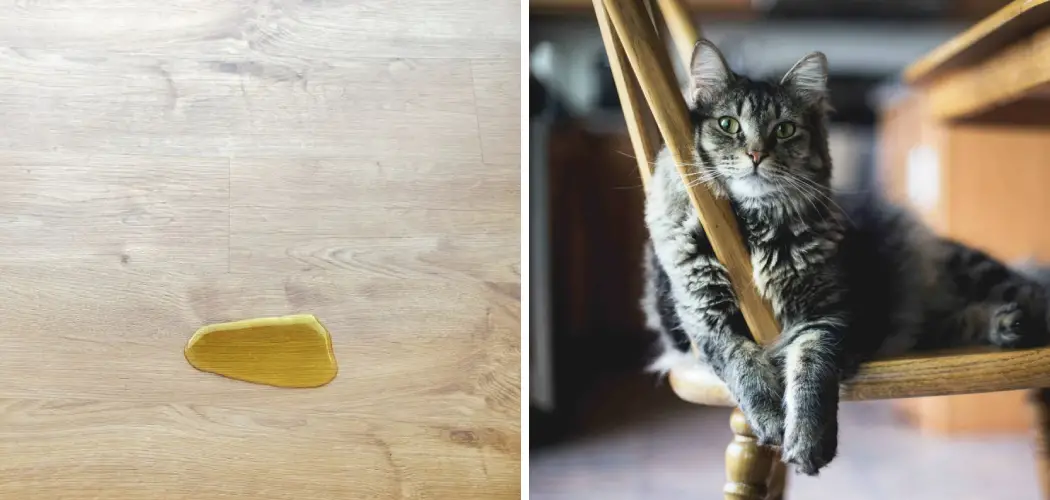If you’ve ever had a naughty cat that has made its mark on your prized wood furniture, then you know how frustrating it can be to try and remove the smelly mess. Not only does cat urine cause an unpleasant odor, but it can also permanently stain wooden surfaces if not taken care of properly. Fortunately, we have some tips for getting rid of this problem.
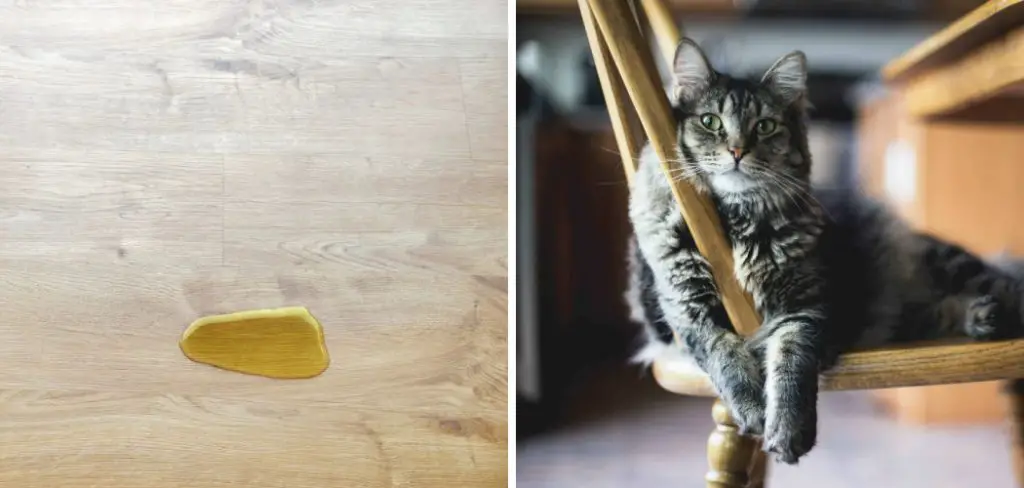
Whether your cat has an accident on your wooden table, chair, or any other furniture piece, these methods will help you get rid of that unpleasant odor and unsightly stain for good. In this blog post, we’ll show you how to get cat pee out of wood furniture without breaking the bank or constantly struggling with potent smells in your home.
So, let’s learn how to keep our beloved wood pieces free from stubborn cat stains!
What Will You Need?
Before we dive into the solutions, let’s take a look at what you’ll need to get rid of cat urine from your wood furniture:
- White vinegar
- Baking soda
- Hydrogen peroxide
- Dish soap or enzyme cleaner
- Clean cloth or paper towels
- Water
Once you have these items on hand, you’re ready to tackle that pesky cat pee!
10 Easy Steps on How to Get Cat Pee Out of Wood Furniture
Step 1: Blot the Affected Area
When cleaning up cat urine from wood furniture, time is of the essence. When you notice the accident, gently grab a clean cloth or paper towel and blot the area. Avoid rubbing, as this can push the urine more deeply into the wood fibers.
Step 2: Apply Vinegar Solution
Once you’ve blotted as much urine as possible, it’s time to neutralize the remaining odor. Make a solution of equal parts white vinegar and warm water. The acidity in the vinegar will work to counteract the alkalinity in the urine and help to neutralize the smell. Apply this solution to the affected area using a clean cloth, ensuring it penetrates the wood surface. Allow the solution to sit for about 10 minutes before blotting it dry.
Step 3: Sprinkle Baking Soda
After blotting dry the vinegar solution, the next step is to sprinkle the area liberally with baking soda. Baking soda is an excellent odor adsorbent and will help pull any remaining smells out of the wood. Let the baking soda sit on the furniture for about an hour to absorb the odor fully. After an hour, wipe away the baking soda with a clean, dry cloth.
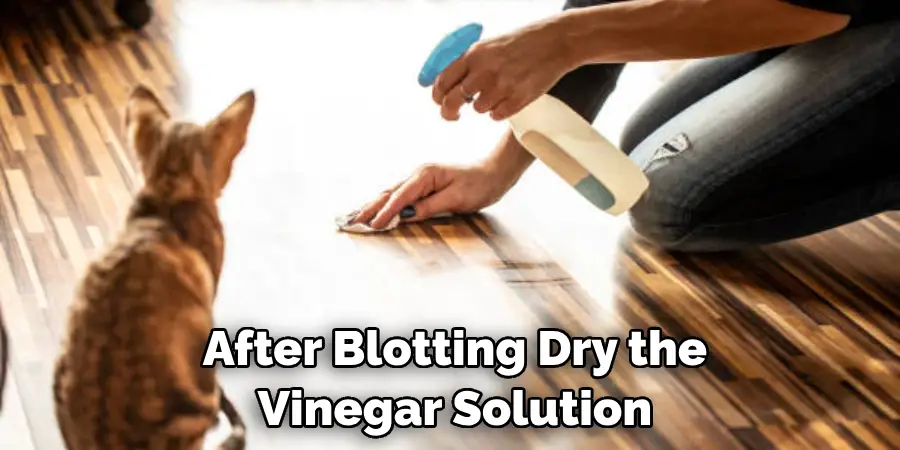
Step 4: Apply Hydrogen Peroxide
If the stain or odor persists, use hydrogen peroxide following the baking soda treatment. Before applying, it’s essential to test hydrogen peroxide on a hidden part of your wood furniture to ensure it doesn’t discolor the wood. Once you’ve confirmed it’s safe, pour some hydrogen peroxide on the stain. Let it sit for a few minutes before blotting it dry. This process can help further break down the odor-causing bacteria from the cat’s urine.
Step 5: Clean with Dish Soap or Enzyme Cleaner
For the final touch, use dish soap or a commercial enzyme cleaner. Enzyme cleaners are particularly effective because they can break down the proteins in cat urine, eliminating the odor. Apply your chosen cleaner to the stained area and gently scrub with a soft brush or cloth. Once done, blot it dry.
Step 6: Rinse and Dry
After cleaning the area, rinse it with water to remove any soap residue. Be careful not to soak the wood. Once rinsed, blot the area dry with a clean cloth or paper towel. Remember, leaving moisture on wood for too long can cause damage, so ensure the area is thoroughly dried.
Step 7: Evaluate the Area
Once the area is completely dry, take a close look and sniff it. If you can still see or smell the stain, you may need to repeat the previous steps. Remember, cat urine is stubborn and may require multiple applications of the cleaning solutions to eliminate. Patience is key in this process.
Step 8: Apply a Sealant
Once you’re confident that the stain and odor are entirely gone, it’s time to consider applying a sealant to the area. This can help protect the wood from future incidents, and it can also help to lock in any residual odors that might be left. Choose a sealant that is appropriate for the type of wood your furniture is made from, and always make sure to test it on an inconspicuous area first to make sure it won’t discolor or damage the wood. Apply the sealant according to the manufacturer’s instructions, and allow it to dry completely before using the furniture piece again.
Step 9: Prevent Future Accidents
After you’ve thoroughly cleaned and sealed your furniture, it’s time to address the cause of the issue to prevent future accidents. If your cat is frequently urinating outside its litter box, it could indicate a behavioral or medical issue. Consult with your vet to rule out any health problems. If it’s behavioral, consider adjusting your pet’s environment, adding more litter boxes, or using products designed to deter cats from marking. Remember, understanding and addressing the root cause of your cat’s behavior is the most effective way to prevent repeat incidents on your wood furniture.
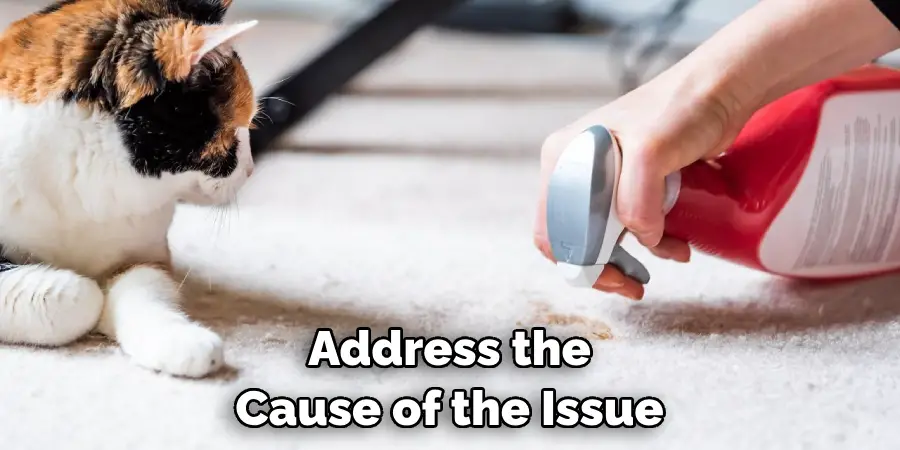
Step 10: Regularly Check Furniture
To keep your furniture in the best possible condition, make sure to check it regularly for any signs of cat urine. The sooner you spot and clean up any accidents, the less likely it is that there will be any lasting damage or odors. Regular maintenance is key to preserving the life and beauty of your wood furniture.
By following these simple steps, you can easily get cat pee out of wood furniture and keep it looking and smelling fresh.
5 Additional Tips and Tricks
- Use UV Light: A UV flashlight can help you identify even the smallest urine stains that are invisible to the naked eye. The urine stains will glow under the UV light, making them easier to spot and clean up.
- Invest in a Good Enzyme Cleaner: Not all enzyme cleaners are equal. To get the most effective results, look for one that is specifically formulated to tackle cat urine.
- Avoid Using Ammonia-Based Cleaners: Cats have a strong sense of smell, and ammonia-based cleaners can actually encourage them to urinate in the same spot again.
- Do Regular Litter Box Maintenance: Regularly cleaning your cat’s litter box and refilling it with fresh litter can discourage urinating elsewhere.
- Use Protective Covers: Consider using protective covers or pads on your furniture, especially when you’re not home, to prevent future accidents. They are easy to remove and wash, and can be a lifesaver when it comes to preserving your furniture.

By incorporating these additional tips and tricks into your cleaning routine, you can further ensure the cleanliness and longevity of your wood furniture.
5 Things You Should Avoid
- Over-saturating the Wood: While you might be tempted to douse the stain thoroughly, it’s vital to avoid over-saturating the wood with any liquid, as this can cause the wood to warp or discolor.
- Scrubbing Aggressively: Intense scrubbing can end up damaging the wood finish. It’s crucial to apply gentle pressure while cleaning the affected area.
- Ignoring the Issue: Cat urine can cause permanent damage if left untreated, so never ignore the issue. Address it as soon as you notice it.
- Using the Wrong Cleaning Products: Certain cleaning products, such as bleach or ammonia-based cleaners, can exacerbate the issue instead of resolving it. Always opt for products specifically designed to tackle cat urine.
- Neglecting to Test Cleaning Solutions: Before applying any cleaning products, always do a patch test in a hidden area of your furniture to ensure it won’t cause discoloration or damage.
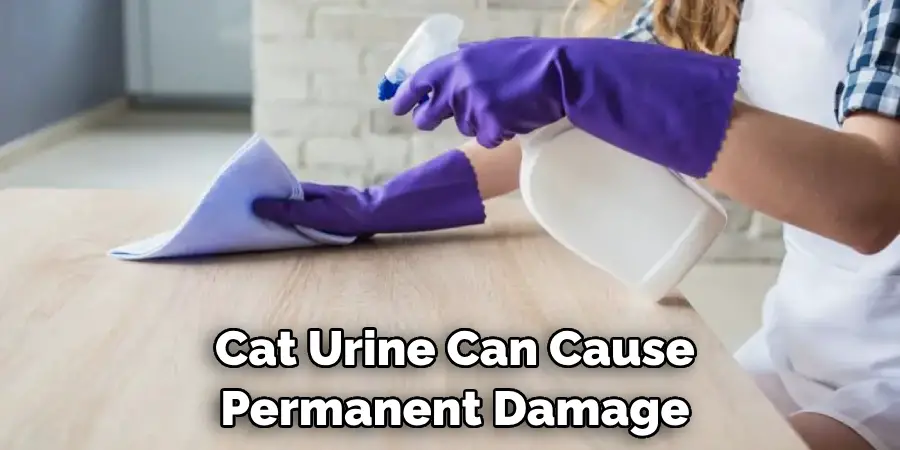
By avoiding these common mistakes, you can more effectively manage the problem without causing further harm to your wood furniture.
Conclusion
Overall, getting the cat pee out of wood furniture is quite the task. But with the right approach and the right cleaning products you can get it looking like new again. The most important thing to remember is never to let it sit – the longer a stain sits in, the harder it will be to get it out. With that in mind, take action as soon as possible for best results and give your furniture a fresh start today!
Hopefully, the article on how to get cat pee out of wood furniture will be helpful for you in dealing with this pesky problem. Remember to handle the issue with patience and persistence continually, and don’t forget to show your feline friend some extra love and attention to prevent future incidents.
Why not go ahead and test out this method on one piece of wood furniture? Once you see how effective this method can be, you’ll be ready to take on even more challenging tasks. So don’t wait any longer; grab your supplies and start removing pet odors from your wood furniture now!
You Can Check It Out Why Does My Cat Lick the Shower Curtain

